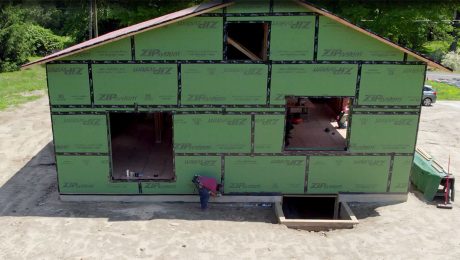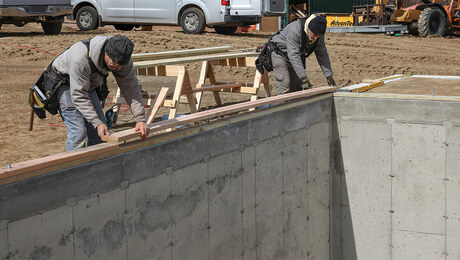Installing Housewrap
When properly detailed, high-tech wrappings can reduce the flow of air into outside walls while allowing moisture to escape.

Synopsis: There’s more to installing housewrap than getting out a utility knife and stapler. This article explains how it should be installed to get the maximum benefit from this commonplace building material. A sidebar discusses the merits of taping sheathing instead of using housewrap.
Build tight, ventilate right. A slogan with roots in energy-efficient building is gaining acceptance in mainstream construction. More builders are installing better insulation and sealing the warm side of walls and floors to keep vapor out of insulated spaces. They’re installing ventilation systems to maintain healthful indoor air quality. But from what we’ve seen, the same care isn’t taken with air-infiltration retarders, also known as air barriers or housewraps.
There are usually a couple of ways to do something right and dozens of ways to do it wrong. Most of the housewrap installations we’ve seen in our area fall into the latter category. Sure, the walls might seem covered, but there are enough seams, gaps, tears and holes at critical spots to render the film ineffective. We asked some builders why they use air-infiltration retarders, and we got some interesting answers: “What’s an air-infiltration retarder?”
“That’s what’s spec-ed on the plans.” “It’s better than tar paper,” “I only use it because customers expect it.” “It makes the house waterproof.” “It dries in the building until the siding goes on.” Because we know what housewraps are supposed to do, we apply the details that will make the barriers most effective. We’ve also learned how to coordinate installation with our framing habits to make installation easy. We’ve installed every major brand of housewrap and have found little or no difference in installation. Although Tyvek was specified for this project, we usually request Typar because its gray color is easier on the eyes than bright white housewraps.
Housewraps are an effective product when installed correctly
Air-infiltration retarders enhance the thermal efficiency of exterior walls by reducing air movement through walls and into wall cavities. A properly installed wrap slows or stops wind- or pressure-driven air from moving freely through gaps and holes in sheathing or around window frames and door jambs. Reducing drafts makes a house feel more comfortable and saves energy. At the same time, housewraps allow moisture vapor that enters the wall cavity to escape. Without this feature, moisture could build up, and rot could begin inside the wall.
Before housewraps entered the market, we used 15-lb. tar paper or red rosin paper beneath our siding. We surmise now that tar paper did a pretty good job of reducing air infiltration and was waterproof.
On occasion, tar paper caused us problems. Stains bled through wood siding, and dissolved tar leaked onto vinyl siding. During remodeling jobs, we sometimes find concealed rot caused by years of condensation behind tar paper.
Rosin paper probably helped to reduce some air infiltration and to let moisture escape. But it disintegrated if it got wet before siding was installed or if small leaks occurred around windows and along cornerboards. On remodeling jobs we have uncovered old rosin paper that had practically turned to dust.
For more photos and details on installing housewrap, click the View PDF button below.
Fine Homebuilding Recommended Products
Fine Homebuilding receives a commission for items purchased through links on this site, including Amazon Associates and other affiliate advertising programs.

Plate Level

Anchor Bolt Marker

100-ft. Tape Measure

























